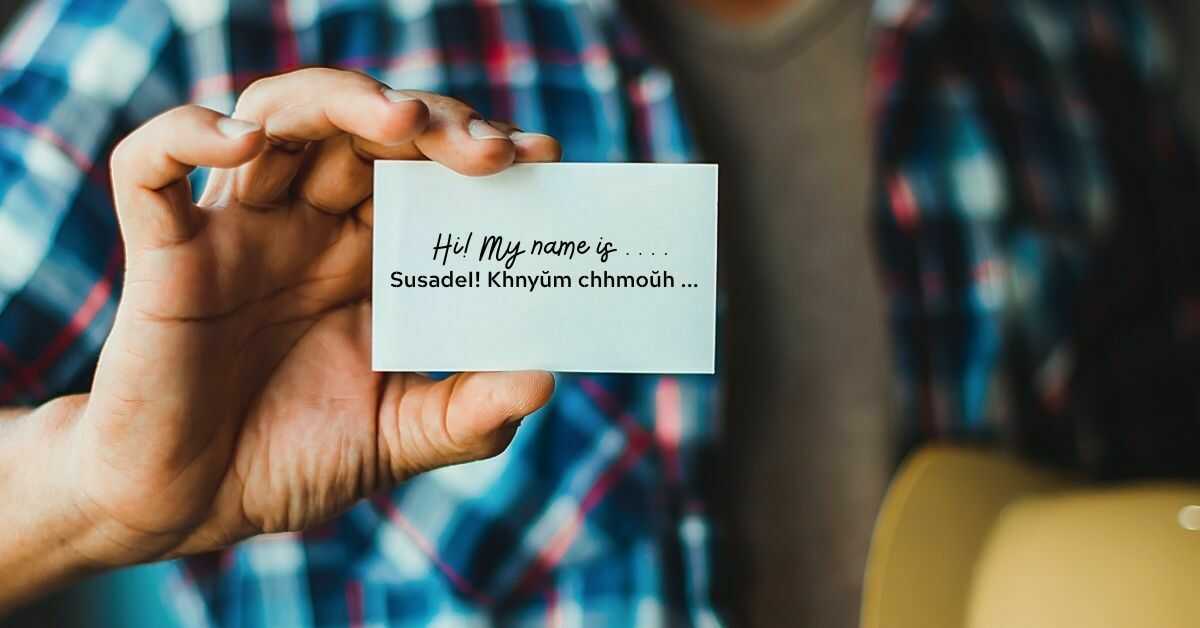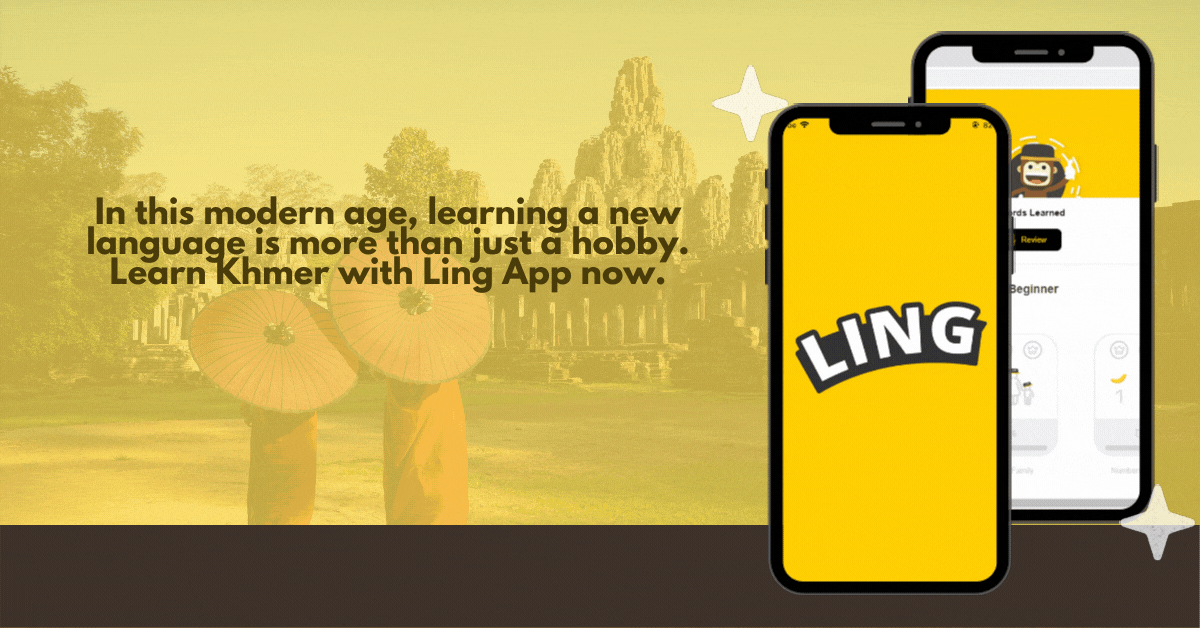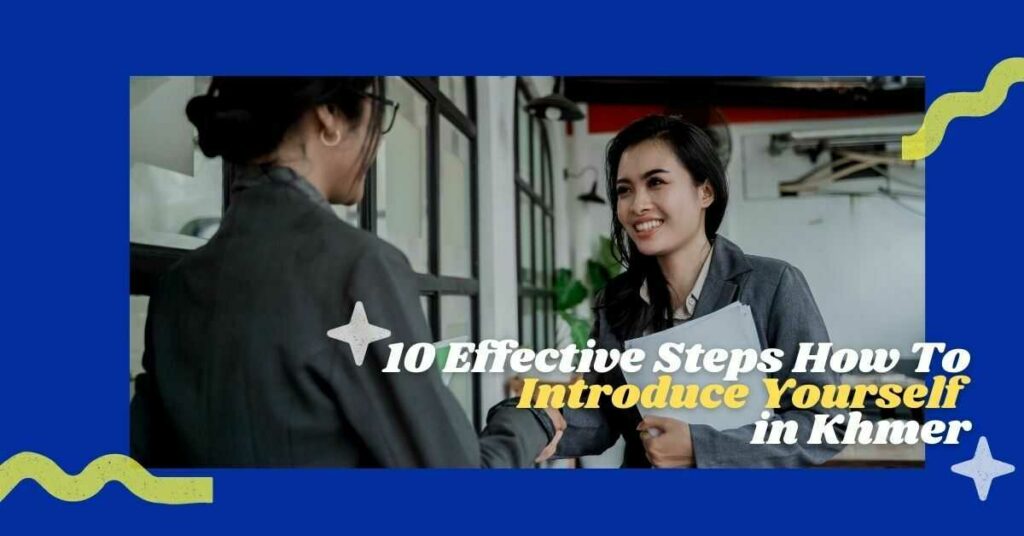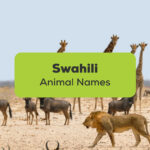Introducing yourself nowadays can be done by just making an online profile on different social media platforms. But how can it help you build meaningful and sincere connections with people?
Imagine going to Cambodia without knowing anyone? How can you feel true fulfillment if you can’t talk with the locals? Saying khnyŭm chhmoŭh … (ខ្ងុំឈ្មោះ …) or learning how to introduce yourself in Khmer is important. If you plan to visit the country and connect with people, you really need to start a conversation by introducing yourself first. So, prepare yourself to feel like we’re on our first day of school again. Get ready to introduce yourself in the Khmer language!
Let’s First Introduce The Khmer Language
Khmer, also known as the Cambodian language, is considered the official language of Cambodia. Most Cambodians speak it. If you are new to Cambodia and have experience traveling to neighboring countries like Vietnam and Thai, you can probably see some similarities. This is because Khmer is a Mon-Khmer language, and it also came from Pali and Sanskrit roots. If you want to learn more about the Khmer language, like Khmer words and phrases, alphabet, and more, you can check Ling App for free lessons and other blog posts like this.
Self Introduction Using Khmer Words: Why Is It Important?
Introducing yourself is an essential factor in conversations and building relationships. When we were a child, our first activity introduced ourselves during the first day of the school year. From this, we will know who the people we can talk to and relate to are.
This is the same when we are visiting Cambodia. Learning how to introduce yourself in Khmer would open doors in many opportunities and advantages. For starters, it is a simple yet one of the most effective ways to break the ice in meeting new people. It also enables you to meet (chuob /ជួប) other people confidently.
In the context of business (achivokam / អាជីវកម្ម), introducing yourself properly will provide a good impression to other people. It also enhances your public speaking skills when talking in front of a large audience.
For travelers who want to explore the culture of Cambodia, knowing how to introduce yourself in Khmer is not only a form of establishing connections with the Cambodian people, but it is also a sign that you respect and appreciate their culture.
Words And Phrases Used To Introduce Yourself In Khmer

Now that you have learned a little about the Khmer language and the importance of introducing yourself in Khmer, let’s find the right Khmer words and phrases to use when introducing yourself in the Khmer language. English translations are also available for you to understand it well. Here are the steps how to introduce yourself in Khmer.
Step 1: Why Not Start With A Greeting?
Hello – Chom Reap Sour (ជំរាបសួរ ) / Susadei (សួស្តី)
The first step is greetings. You can never go wrong with opening a conversation through a greeting like the one mentioned above. This is a good ice breaker and prevents awkward first meeting scenarios. If you have opened up a friendly greeting, this will immediately show that you are a polite and well-mannered person.
There are other greetings that you can use. If you want to learn more, check the blog post entitled “Hello in Khmer & Other Greetings.” There are also other blog posts if you want to learn Khmer more.
Step 2: What’s Your Name?
My name is … – khnyŭm chhmoŭh … (ខ្ងុំឈ្មោះ …)
The next step on how to introduce yourself in Khmer is introducing your name. When you were asked “ânâk chhmoŭh ei? (អ្នកឈ្មោះអី?) or What’s your name?”, this is the basic and the easiest way to respond and introduce yourself. You can use this in formal and informal situations, especially if you know a little about Cambodian culture. You need to add your name at the end, and you’re good to go.
I am … – khnyŭm ku … (ខ្ញុំគឺ …)
You can also use this phrase to make it easier for you. If you want to learn Khmer, start with the easiest ones, but it wouldn’t hurt to learn the standard way to avoid misunderstandings with the locals.
Step 3: Where Are You From?
I’m from – ខ្ងុំមកពី … (khynŭm mô pi …)
If you are asked the question “ânâk mô pi brôté an? (អ្នកមកពីប្រទេសណា?) or Where are you from?”, you can use the phrase above to answer. Proudly introducing where you came from is another exciting way to introduce yourself. This will open up to different conversation pieces in the future. For example, to say country in Khmer, use brates (ប្រទេស). Below are examples of Southeast Asian countries in the Khmer language:
| Khmer | Pronunciation | English Translation |
| ប្រ៊ុយណេ | brouyne | Brunei |
| មីយ៉ាន់ម៉ា | miyeanmea | Myanmar |
| ទីម័រខាងកើត | timrkhangkaet | Timor-Leste |
| ឥណ្ឌូនេស៊ី | indau ne sai | Indonesia |
| ឡាវ | lav | Laos |
| ប្រទេសម៉ាឡេស៊ី | bratesa mealesai | Malaysia |
| ហ្វីលីពីន | hveilipin | Philippine |
| សិង្ហបុរី | senghobori | Singapore |
| ថៃ | Thai | Thailand |
| ប្រទេសវៀតណាម | bratesa vietneam | Vietnam |
Step 4: When’s Your Birthday?
My Birthday is on… – thngaikamnaet robsakhnhom ku now leu …
(ថ្ងៃកំណើតរបស់ខ្ញុំគឺនៅលើ …)
You can also share your date of birth. For example, to say Birthday in Khmer, you can use the word thngaikamnaet (ថ្ងៃកំណើត). If you want to learn the Khmer way of telling dates, you can check the blog “80 Useful Words About Khmer Days and Months“. You can also learn how to greet someone with “Happy Birthday” in Khmer by reading this blog. But, in Cambodia, they don’t usually celebrate their birthday. In fact, some people don’t know what’s their birthday.
Step 5: How Old Are You?
I am 20 years old. – khnhom mean ayou 20 chhnam (ខ្ញុំមានអាយុ ២០ ឆ្នាំ)
After your birthday, you might also be asked about your age, especially if you are applying for a job. People in Cambodia would not ask this if you have just met. However, some people will ask this to know how they should address you because, in Cambodia, spoken language may differ based on the age of the person you are talking to.
Step 6: What’s Your Job? / What Do You Do For Living?
I am a doctor. – khnhom chea kroupety . (ខ្ញុំជាគ្រូពេទ្យ។ )
Your profession or what you do for a living is worth flexing. This will give an impression to other people that you can be successful in life and your chosen career. Some examples of professions in the Khmer language:
| Khmer | Pronunciation | English Translation |
| វិស្វករ | visvakar | engineer |
| វេជ្ជបណ្ឌិត | vechchobandet | doctor |
| គិលានុបដ្ឋាយិកា | kileanoubadthayikea | nurse |
| គ្រូ | krou | teacher |
| ពេទ្យធ្មេញ | petyothmenh | dentist |
| ពេទ្យសត្ | petyosat | veterenarian |
| ស្ថាបត្យករ | sthabatyakar | architect |
| មេធាវី | metheavi | lawyer |
| គណនេយ្យករ | konneyyokar | accountant |
Step 7: Are You Married Or Not?
Single – khnhom ku now liv (ញុំគឺនៅលីវ)
Married – khnhom riebkear ruochhaey (ខ្ញុំរៀបការរួចហើយ)
This information is not typically asked unless you are in the embassy, applying for a job, and of course, when you start dating. For what’s it worth, the Khmer words to use when you are stating your civil status. If you are learning how to introduce yourself in Khmer, this is still important to know.
Step 8: What Are Your Hobbies?
I like to play basketball. – khnhom chaulchett leng balbaoh.
(ខ្ញុំចូលចិត្តលេងបាល់បោះ។)
Another conversation piece is your hobbies. Stating the things you love to do will make you more interesting to other people to know. In addition, this can be an excellent opportunity to meet people with the same hobbies as you. Below are some examples of hobbies in the Khmer language.
| Khmer | Pronunciation | English Translation |
| អានសៀវភៅ | an sievphow | read a book |
| ច្រៀង | chrieng | sing |
| រាំ | roam | dance |
| មើលទូរទស្សន៍ | meul tourotossaa | watch TV |
| ធ្វើដំណើរ | thveudamnaer | travel |
| ឡើងភ្នំ | laengophnom | hike |
Step 9: Do You Know How To Speak The Khmer Language?
Yes – Baht (បាទ) And Jah (ចា)
No – Ot-Tei (អត់ទេ/ទេ)
Little – techtuoch (តិចតួច)
This will probably be asked in the first part of your conversation. This will give them an idea of how they should address you and your concern. Some Cambodians cannot speak English, but most can speak, especially those who live in urban places. This is the reason why it is really important to take a Khmer lesson before going to Cambodia.
If you want to know more about different ways on how to say Yes, No, or Ok in Khmer, you may check this blog.
Step 10: Are You Done? Don’t Just End, Say Thank You.
Thank you – Au Kun (ឣរគុណ)
Last but not least is showing gratitude. This is definitely one of the most important things in learning how to introduce yourself in Khmer. A warm welcome should be reciprocated by politeness and respect. Learning how to say Thank you in Khmer can be done in many different ways. You can check the blog post entitled 4 Ways To Say Thank You In Khmer.
How To Respond?
Pleased to meet you – khynŭm trék ’âr na dêl ban skéal loŭk
(ខ្ញុំត្រេកអរណាស់ដែលបានស្គាល់លោក)
Now that you have learned how to introduce yourself in Khmer, you should also know how to respond when someone introduces themselves to you. Saying “Pleased to meet you.” is a way of showing politeness and respect to the other person.
Learn The Khmer Language Now!
Channel your inner Cambodian! After you have learned how to introduce yourself in Khmer, you may now go to the next level in learning Khmer with Ling App.
Did you know that language learning can be more exciting and fun? With Ling App, you can learn new languages like playing a game. Widen your vocabulary through a variety of topics and language lessons arranged in flashcards. Learning the right pronunciation and sound of every word would not be a problem because audio recordings from a native speaker are available.
So if you are planning a trip to Cambodia, learning Khmer is one of the first things you should do, and you couldn’t ask for a better app to help you than Ling App. How? Just search Ling App on the internet, make an account, and log in or download the app in your App Store or Play Store.

In this modern age, learning a new language is more than just a hobby. It is an investment that you can use someday. It is another way of introducing yourself to other cultures from different parts of the world. So, learn Khmer now!



































































